Abstract
In pollen development, a dramatic reorganization of the actin cytoskeleton takes place during the passage of the pollen grain into dormancy and on activation of pollen tube growth. A role for actin-binding proteins is implicated and we report here the identification of a small gene family in maize that encodes actin depolymerizing factor (ADF)-like proteins. The ADF group of proteins are believed to control actin polymerization and depolymerization in response to both intracellular and extracellular signals. Two of the maize genes ZmABP1 and ZmABP2 are expressed specifically in pollen and germinating pollen suggesting that the protein products may be involved in pollen actin reorganization. A third gene, ZmABP3, encodes a protein only 56% and 58% identical to ZmABP1 and ZmABP2, respectively, and its expression is suppressed in pollen and germinated pollen. The fundamental biochemical characteristics of the ZmABP proteins has been elucidated using bacterially expressed ZmABP3 protein. This has the ability to bind monomeric actin (G-actin) and filamentous actin (F-actin). Moreover, it decreases the viscosity of polymerized actin solutions consistent with an ability to depolymerize filaments. These biochemical characteristics, taken together with the sequence comparisons, support the inclusion of the ZmABP proteins in the ADF group.
Full text
PDF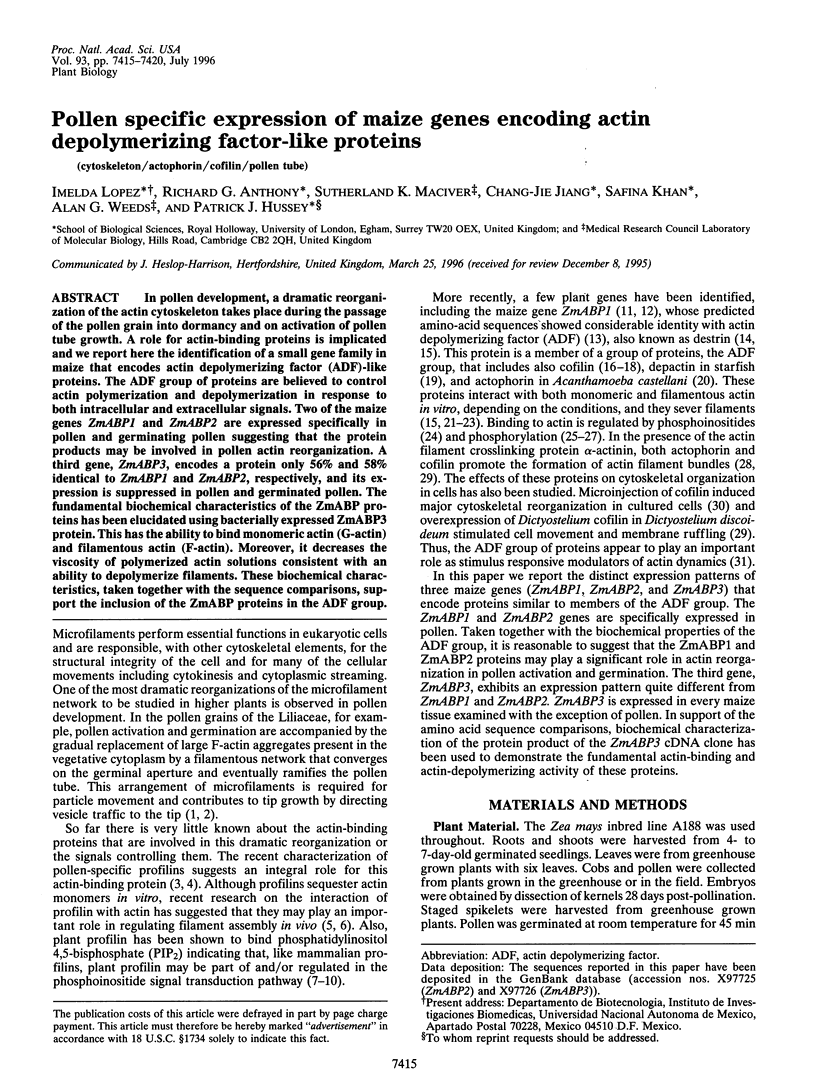
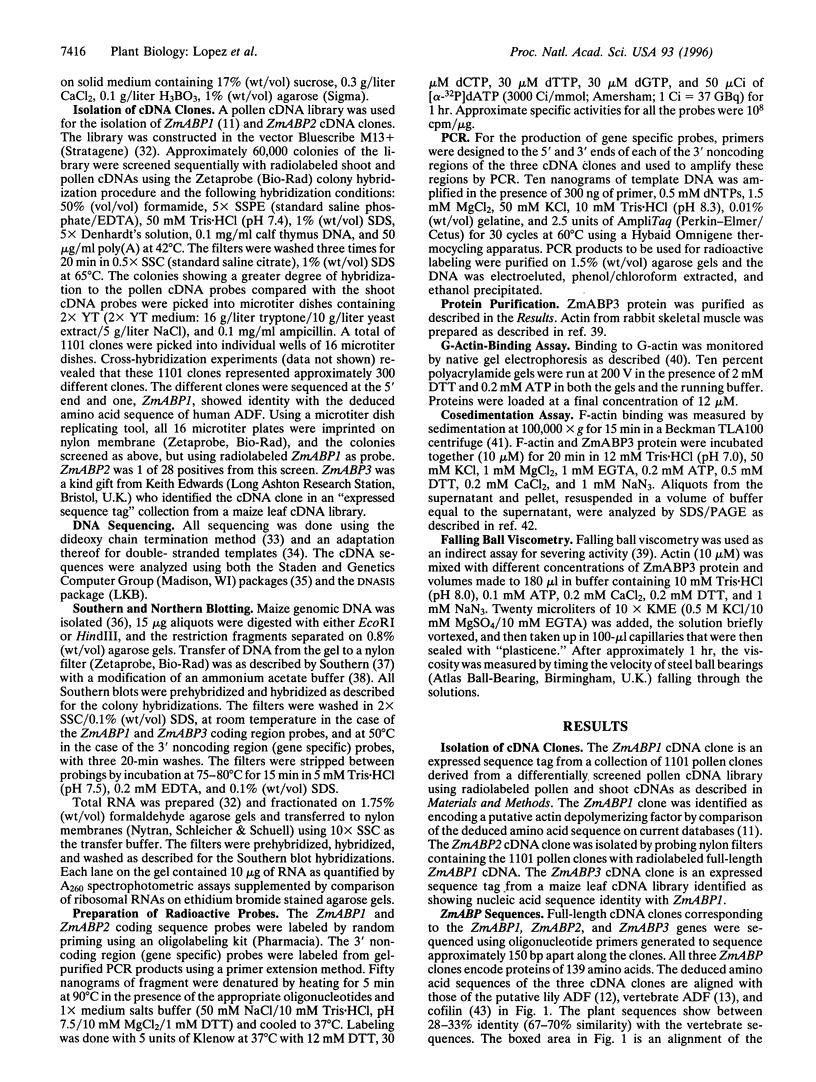
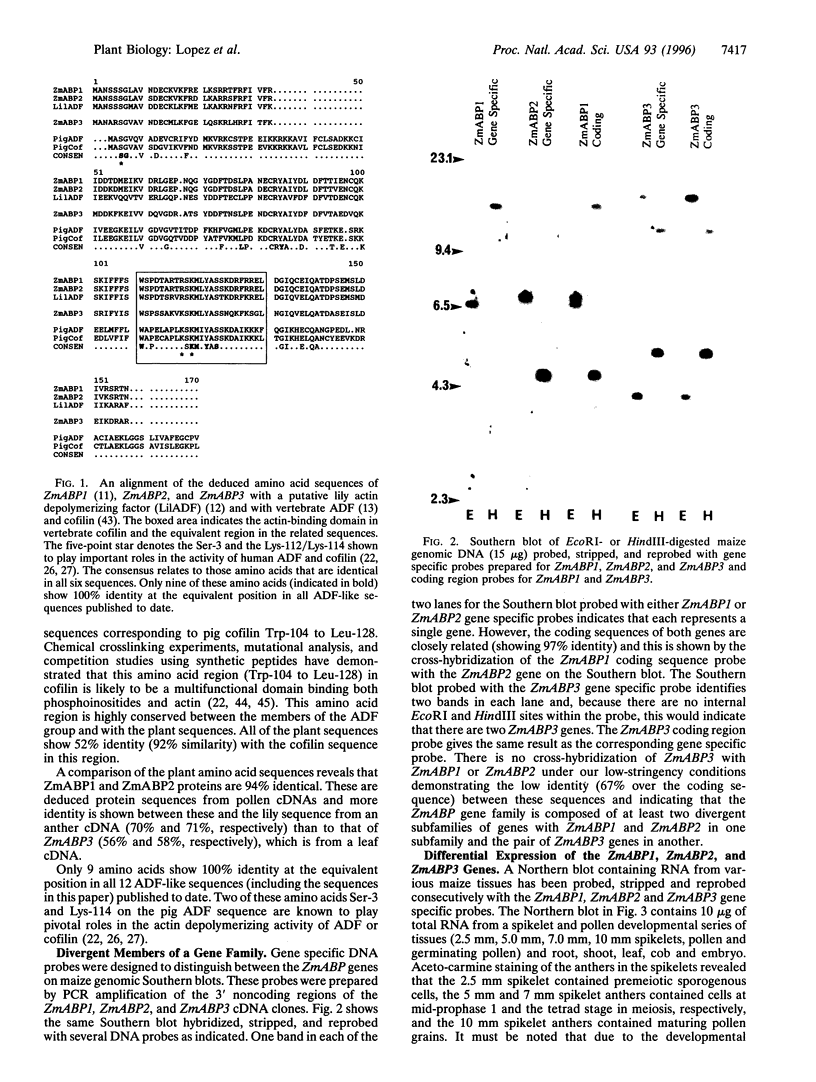
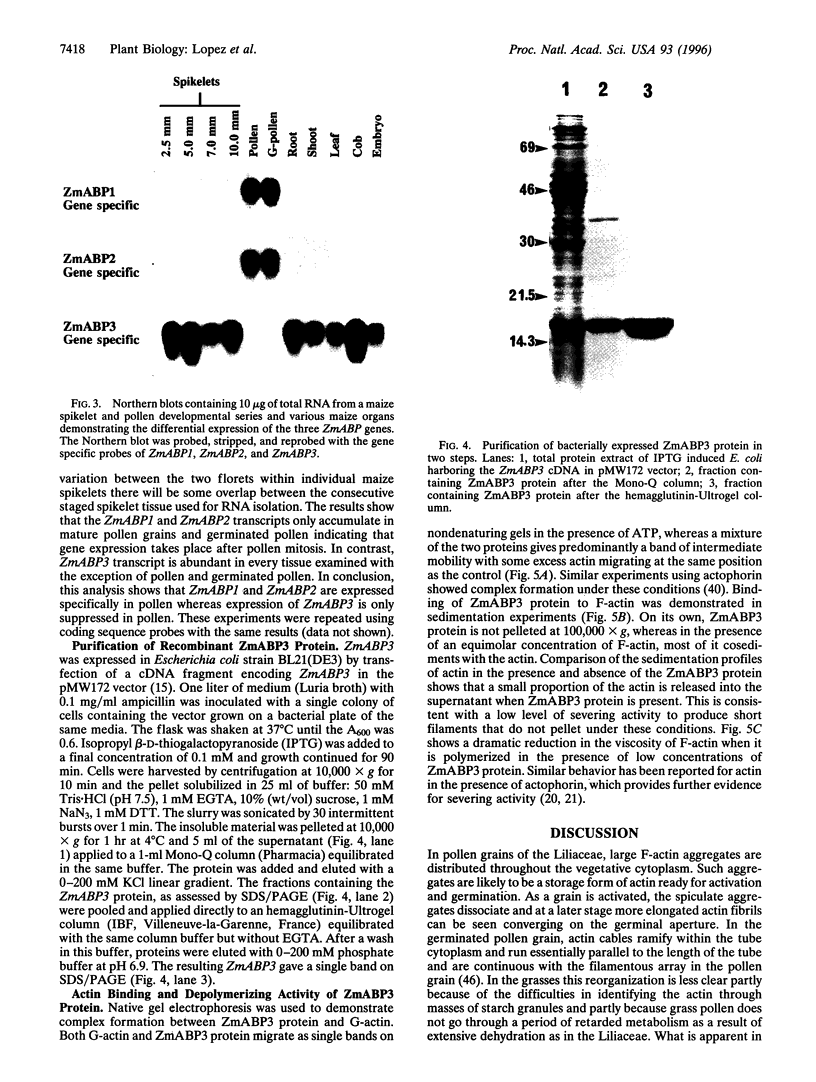
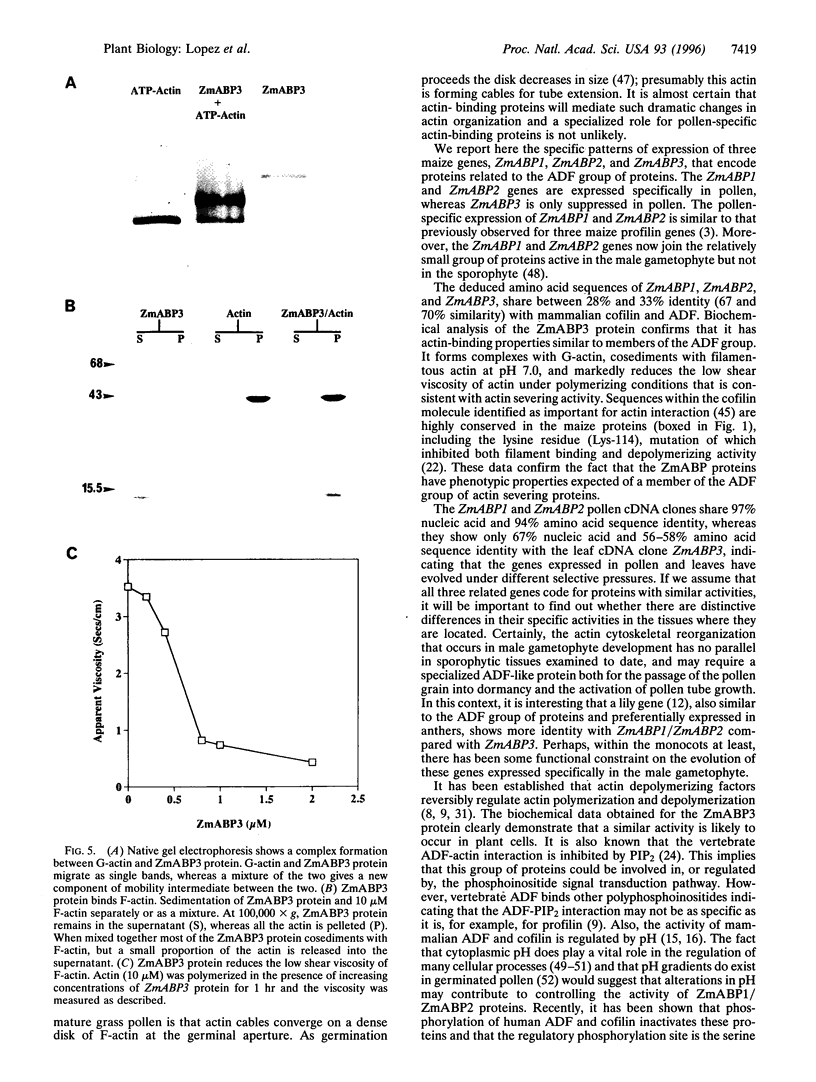

Images in this article
Selected References
These references are in PubMed. This may not be the complete list of references from this article.
- Adams M. E., Minamide L. S., Duester G., Bamburg J. R. Nucleotide sequence and expression of a cDNA encoding chick brain actin depolymerizing factor. Biochemistry. 1990 Aug 14;29(32):7414–7420. doi: 10.1021/bi00484a009. [DOI] [PubMed] [Google Scholar]
- Agnew B. J., Minamide L. S., Bamburg J. R. Reactivation of phosphorylated actin depolymerizing factor and identification of the regulatory site. J Biol Chem. 1995 Jul 21;270(29):17582–17587. doi: 10.1074/jbc.270.29.17582. [DOI] [PubMed] [Google Scholar]
- Aizawa H., Sutoh K., Tsubuki S., Kawashima S., Ishii A., Yahara I. Identification, characterization, and intracellular distribution of cofilin in Dictyostelium discoideum. J Biol Chem. 1995 May 5;270(18):10923–10932. doi: 10.1074/jbc.270.18.10923. [DOI] [PubMed] [Google Scholar]
- Aizawa H., Sutoh K., Yahara I. Overexpression of cofilin stimulates bundling of actin filaments, membrane ruffling, and cell movement in Dictyostelium. J Cell Biol. 1996 Feb;132(3):335–344. doi: 10.1083/jcb.132.3.335. [DOI] [PMC free article] [PubMed] [Google Scholar]
- Cooper J. A., Blum J. D., Williams R. C., Jr, Pollard T. D. Purification and characterization of actophorin, a new 15,000-dalton actin-binding protein from Acanthamoeba castellanii. J Biol Chem. 1986 Jan 5;261(1):477–485. [PubMed] [Google Scholar]
- Devereux J., Haeberli P., Smithies O. A comprehensive set of sequence analysis programs for the VAX. Nucleic Acids Res. 1984 Jan 11;12(1 Pt 1):387–395. doi: 10.1093/nar/12.1part1.387. [DOI] [PMC free article] [PubMed] [Google Scholar]
- Drøbak B. K. The plant phosphoinositide system. Biochem J. 1992 Dec 15;288(Pt 3):697–712. doi: 10.1042/bj2880697. [DOI] [PMC free article] [PubMed] [Google Scholar]
- Hartwig J. H., Kwiatkowski D. J. Actin-binding proteins. Curr Opin Cell Biol. 1991 Feb;3(1):87–97. doi: 10.1016/0955-0674(91)90170-4. [DOI] [PubMed] [Google Scholar]
- Hawkins M., Pope B., Maciver S. K., Weeds A. G. Human actin depolymerizing factor mediates a pH-sensitive destruction of actin filaments. Biochemistry. 1993 Sep 28;32(38):9985–9993. doi: 10.1021/bi00089a014. [DOI] [PubMed] [Google Scholar]
- Hayden S. M., Miller P. S., Brauweiler A., Bamburg J. R. Analysis of the interactions of actin depolymerizing factor with G- and F-actin. Biochemistry. 1993 Sep 28;32(38):9994–10004. doi: 10.1021/bi00089a015. [DOI] [PubMed] [Google Scholar]
- Iida K., Moriyama K., Matsumoto S., Kawasaki H., Nishida E., Yahara I. Isolation of a yeast essential gene, COF1, that encodes a homologue of mammalian cofilin, a low-M(r) actin-binding and depolymerizing protein. Gene. 1993 Feb 14;124(1):115–120. doi: 10.1016/0378-1119(93)90770-4. [DOI] [PubMed] [Google Scholar]
- Kim S. R., Kim Y., An G. Molecular cloning and characterization of anther-preferential cDNA encoding a putative actin-depolymerizing factor. Plant Mol Biol. 1993 Jan;21(1):39–45. doi: 10.1007/BF00039616. [DOI] [PubMed] [Google Scholar]
- Larkin J. C., Hunsperger J. P., Culley D., Rubenstein I., Silflow C. D. The organization and expression of a maize ribosomal protein gene family. Genes Dev. 1989 Apr;3(4):500–509. doi: 10.1101/gad.3.4.500. [DOI] [PubMed] [Google Scholar]
- Mabuchi I. Purification from starfish eggs of a protein that depolymerizes actin. J Biochem. 1981 Apr;89(4):1341–1344. [PubMed] [Google Scholar]
- MacLean-Fletcher S., Pollard T. D. Mechanism of action of cytochalasin B on actin. Cell. 1980 Jun;20(2):329–341. doi: 10.1016/0092-8674(80)90619-4. [DOI] [PubMed] [Google Scholar]
- Maciver S. K., Wachsstock D. H., Schwarz W. H., Pollard T. D. The actin filament severing protein actophorin promotes the formation of rigid bundles of actin filaments crosslinked with alpha-actinin. J Cell Biol. 1991 Dec;115(6):1621–1628. doi: 10.1083/jcb.115.6.1621. [DOI] [PMC free article] [PubMed] [Google Scholar]
- Maciver S. K., Weeds A. G. Actophorin preferentially binds monomeric ADP-actin over ATP-bound actin: consequences for cell locomotion. FEBS Lett. 1994 Jun 27;347(2-3):251–256. doi: 10.1016/0014-5793(94)00552-4. [DOI] [PubMed] [Google Scholar]
- Maciver S. K., Zot H. G., Pollard T. D. Characterization of actin filament severing by actophorin from Acanthamoeba castellanii. J Cell Biol. 1991 Dec;115(6):1611–1620. doi: 10.1083/jcb.115.6.1611. [DOI] [PMC free article] [PubMed] [Google Scholar]
- Mascarenhas J. P. Molecular Mechanisms of Pollen Tube Growth and Differentiation. Plant Cell. 1993 Oct;5(10):1303–1314. doi: 10.1105/tpc.5.10.1303. [DOI] [PMC free article] [PubMed] [Google Scholar]
- Matsuzaki F., Matsumoto S., Yahara I., Yonezawa N., Nishida E., Sakai H. Cloning and characterization of porcine brain cofilin cDNA. Cofilin contains the nuclear transport signal sequence. J Biol Chem. 1988 Aug 15;263(23):11564–11568. [PubMed] [Google Scholar]
- Moon A., Drubin D. G. The ADF/cofilin proteins: stimulus-responsive modulators of actin dynamics. Mol Biol Cell. 1995 Nov;6(11):1423–1431. doi: 10.1091/mbc.6.11.1423. [DOI] [PMC free article] [PubMed] [Google Scholar]
- Moriyama K., Iida K., Yahara I. Phosphorylation of Ser-3 of cofilin regulates its essential function on actin. Genes Cells. 1996 Jan;1(1):73–86. doi: 10.1046/j.1365-2443.1996.05005.x. [DOI] [PubMed] [Google Scholar]
- Moriyama K., Nishida E., Yonezawa N., Sakai H., Matsumoto S., Iida K., Yahara I. Destrin, a mammalian actin-depolymerizing protein, is closely related to cofilin. Cloning and expression of porcine brain destrin cDNA. J Biol Chem. 1990 Apr 5;265(10):5768–5773. [PubMed] [Google Scholar]
- Moriyama K., Yonezawa N., Sakai H., Yahara I., Nishida E. Mutational analysis of an actin-binding site of cofilin and characterization of chimeric proteins between cofilin and destrin. J Biol Chem. 1992 Apr 15;267(11):7240–7244. [PubMed] [Google Scholar]
- Murphy G., Kavanagh T. Speeding-up the sequencing of double-stranded DNA. Nucleic Acids Res. 1988 Jun 10;16(11):5198–5198. doi: 10.1093/nar/16.11.5198. [DOI] [PMC free article] [PubMed] [Google Scholar]
- Nagaoka R., Kusano K., Abe H., Obinata T. Effects of cofilin on actin filamentous structures in cultured muscle cells. Intracellular regulation of cofilin action. J Cell Sci. 1995 Feb;108(Pt 2):581–593. doi: 10.1242/jcs.108.2.581. [DOI] [PubMed] [Google Scholar]
- Nishida E., Maekawa S., Sakai H. Cofilin, a protein in porcine brain that binds to actin filaments and inhibits their interactions with myosin and tropomyosin. Biochemistry. 1984 Oct 23;23(22):5307–5313. doi: 10.1021/bi00317a032. [DOI] [PubMed] [Google Scholar]
- Pantaloni D., Carlier M. F. How profilin promotes actin filament assembly in the presence of thymosin beta 4. Cell. 1993 Dec 3;75(5):1007–1014. doi: 10.1016/0092-8674(93)90544-z. [DOI] [PubMed] [Google Scholar]
- Pope B., Weeds A. G. Binding of pig plasma gelsolin to F-actin and partial fractionation into calcium-dependent and calcium-independent forms. Eur J Biochem. 1986 Nov 17;161(1):85–93. doi: 10.1111/j.1432-1033.1986.tb10127.x. [DOI] [PubMed] [Google Scholar]
- Pouysségur J., Sardet C., Franchi A., L'Allemain G., Paris S. A specific mutation abolishing Na+/H+ antiport activity in hamster fibroblasts precludes growth at neutral and acidic pH. Proc Natl Acad Sci U S A. 1984 Aug;81(15):4833–4837. doi: 10.1073/pnas.81.15.4833. [DOI] [PMC free article] [PubMed] [Google Scholar]
- Rigaud G., Grange T., Pictet R. The use of NaOH as transfer solution of DNA onto nylon membrane decreases the hybridization efficiency. Nucleic Acids Res. 1987 Jan 26;15(2):857–857. doi: 10.1093/nar/15.2.857. [DOI] [PMC free article] [PubMed] [Google Scholar]
- Rozycka M., Khan S., Lopez I., Greenland A. J., Hussey P. J. A Zea mays pollen cDNA encoding a putative actin-depolymerizing factor. Plant Physiol. 1995 Mar;107(3):1011–1012. doi: 10.1104/pp.107.3.1011. [DOI] [PMC free article] [PubMed] [Google Scholar]
- Southern E. M. Detection of specific sequences among DNA fragments separated by gel electrophoresis. J Mol Biol. 1975 Nov 5;98(3):503–517. doi: 10.1016/s0022-2836(75)80083-0. [DOI] [PubMed] [Google Scholar]
- Staiger C. J., Goodbody K. C., Hussey P. J., Valenta R., Drøbak B. K., Lloyd C. W. The profilin multigene family of maize: differential expression of three isoforms. Plant J. 1993 Oct;4(4):631–641. doi: 10.1046/j.1365-313x.1993.04040631.x. [DOI] [PubMed] [Google Scholar]
- Sun H. Q., Kwiatkowska K., Yin H. L. Actin monomer binding proteins. Curr Opin Cell Biol. 1995 Feb;7(1):102–110. doi: 10.1016/0955-0674(95)80051-4. [DOI] [PubMed] [Google Scholar]
- Theriot J. A., Mitchison T. J. The three faces of profilin. Cell. 1993 Dec 3;75(5):835–838. doi: 10.1016/0092-8674(93)90527-w. [DOI] [PubMed] [Google Scholar]
- Valenta R., Duchêne M., Pettenburger K., Sillaber C., Valent P., Bettelheim P., Breitenbach M., Rumpold H., Kraft D., Scheiner O. Identification of profilin as a novel pollen allergen; IgE autoreactivity in sensitized individuals. Science. 1991 Aug 2;253(5019):557–560. doi: 10.1126/science.1857985. [DOI] [PubMed] [Google Scholar]
- Way M., Pope B., Weeds A. G. Evidence for functional homology in the F-actin binding domains of gelsolin and alpha-actinin: implications for the requirements of severing and capping. J Cell Biol. 1992 Nov;119(4):835–842. doi: 10.1083/jcb.119.4.835. [DOI] [PMC free article] [PubMed] [Google Scholar]
- Yonezawa N., Homma Y., Yahara I., Sakai H., Nishida E. A short sequence responsible for both phosphoinositide binding and actin binding activities of cofilin. J Biol Chem. 1991 Sep 15;266(26):17218–17221. [PubMed] [Google Scholar]
- Yonezawa N., Nishida E., Iida K., Kumagai H., Yahara I., Sakai H. Inhibition of actin polymerization by a synthetic dodecapeptide patterned on the sequence around the actin-binding site of cofilin. J Biol Chem. 1991 Jun 5;266(16):10485–10489. [PubMed] [Google Scholar]
- Yonezawa N., Nishida E., Iida K., Yahara I., Sakai H. Inhibition of the interactions of cofilin, destrin, and deoxyribonuclease I with actin by phosphoinositides. J Biol Chem. 1990 May 25;265(15):8382–8386. [PubMed] [Google Scholar]






